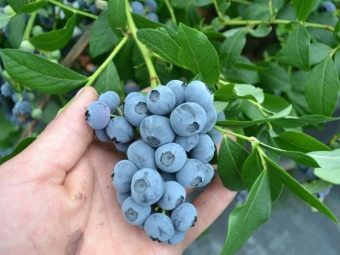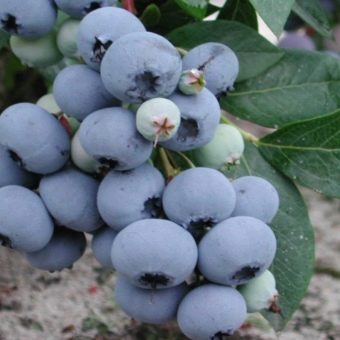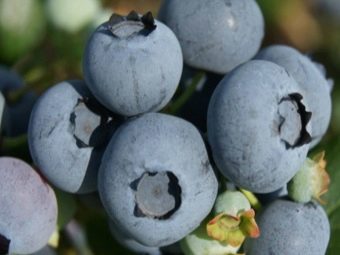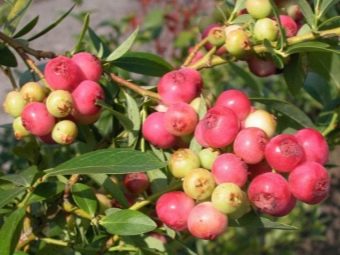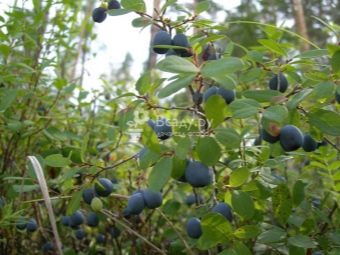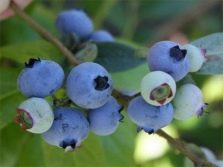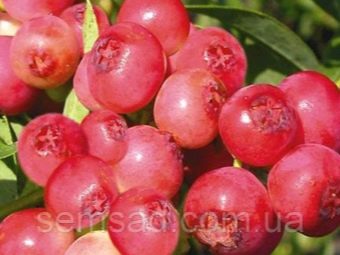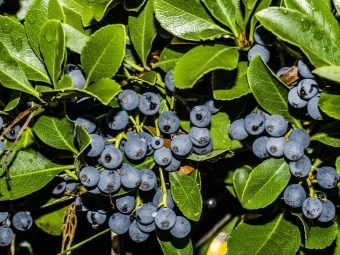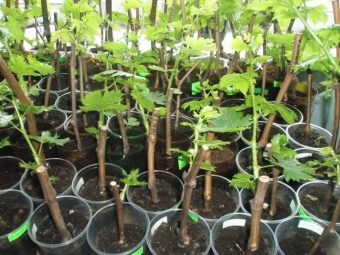Countless varieties of blueberries: the wonders of breeding
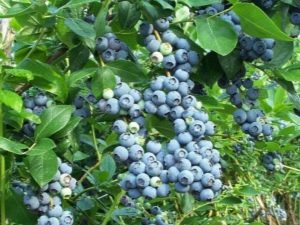
Blueberry is a real storehouse of vitamins, helps the body to withstand a variety of infections and has tonic properties. Berry has been grown for many years in all regions of the country.
Special features
Blueberry bushes come in different heights depending on the variety. The plant withstands low temperatures and is long-lived. Due to the height of the shrub is practically protected from pests, which increases its yield.
As a result of crossing, varieties were obtained that are distinguished by their taste, resistance to temperatures and maturity of the crop. This allows you to grow berries in different climatic conditions. At the moment, more than fifty species of ponobobel (another name for blueberry) are registered.
The berry is planted preferably in open areas, the space between the bushes should be at least one meter. The soil is better to choose peat. A wetland will have a negative effect on the taste of the fruit.
Types and characteristics
There are many varieties of blueberries. We select several of the most common and most beloved gardeners:
- Erliblyu. It is a shrub in height from 1.2 to 1.8 m of upright type, has an average height. Fruiting bush from the beginning of July. The berries are medium in size. The harvest from one bush reaches seven kilograms. The color of the berries is light blue, the taste is pleasant. After full ripening, the berries fall and have dense pulp. Late harvest has a smaller size.
- "Denis". Shrub of medium height - about one and a half meters. The plant is hardy to temperature extremes and to cold winters. Harvest from the bush reaches six pounds. Fruits regularly and has very large berries.
- "Nelson". The plant has a height of 1.5 to 1.8 meters. Fruits in the second decade of August, yields up to 9 pounds per bush. Berries are dense, heavenly color, diameter is about two centimeters. A distinctive feature is a small scar on fruits that have a delicate flavor.
- "Northland". The shrub is a low branchy plant, the branches do not exceed one meter in length. The variety is frost-resistant and is characterized by rapid growth and ripening of fruits. Indigo berries have a sweet taste, the pulp is dense.
- "Chippev". A plant of medium height, winter-hardy, withstands thirty degrees of frost. Shrub fruits very sweet berries of a light heavenly shade. Fruit size varies from medium to large.
- "Northblyu". Shrub height not more than a meter with high resistance to frost. The fruits have ultramarine color, dense flesh and sugar taste. Berries make excellent winter preparations. The plant is also used for decorated landscape designs.
- "Taiga beauty." The plant tolerates frosts to minus 44 degrees. Shrub resistant to most diseases. The fruits have a very flattened round shape of a very large size. The color of the berries is dark blue, the pulp is medium density, the taste is sour. This variety is universal and acceptable for cultivation in agriculture and gardeners-amateurs.
- "Toro". Low shrub with a length of branches up to two meters. It has a high yield. Fruits with a characteristic blue color taste good. The variety is recommended to use for making jam and jelly.
- "Elizabeth". The plant is tall with spreading branches prefers peat soils. Fruits in early August. Indigo berries have a honey flavor and a pleasant aroma. The fruit has dense skin with a scar. Berries do not crease during transport.
- "Spartan". The shrub is late fructifying (late August). The berries have a pleasant smell and taste, the color is pale turquoise, the size of the fruit is about two centimeters. The variety has medium frost resistance and moderate disease resistance. Does not tolerate excessive moisture.
- "Chanticleer". Universal type of blueberry, which is grown on an industrial scale and on individual garden plots. The plant is characterized by an average height, and fruiting begins in early July. The berries have a gray tint, pleasant taste with sourness, the size of the fruit reaches two centimeters in diameter.
- "Bluejay". Srednerosly plant begins to bear fruit by mid-July. The berries have an average size, a light bluish tint and good taste. Differs the fruit of the presence of a small scar. The variety is resistant to cracking and is well transported.
- Brigitte Blue. It is a two-meter bush. Fruits in the second decade of August. The berries are sky blue with a pleasant taste, the size of the fruit is about one and a half centimeters.
- "Blue placer". Low-growing bush has a high frost resistance and disease resistance. The fruits are very large with a bluish tinge, the taste is sweet with a sourness and a pleasant aroma. Have dense pulp.
- North Country. Frost-resistant undersized plant. Fruits in the second decade of July, the berries have an average value. Fruits of characteristic light blue color with sugar taste. Productivity makes up to 2 kg from a bush. Often used as a decorative element of the landscape.
- Pink Lemonade. This miracle of selection. A tall plant has pronounced decorative characteristics and has pink fruits. The berries have a sweet, sour taste and are large in size. Shrub yield is high. The leaves in autumn are painted in unusual colors from pink to red.
- "Canadian nectar". Tall variety differs late fruiting (late August - mid September). The berries have a color from blue to black. The fruit is delicious, rich in vitamins and suitable for any kind of processing.
- "Mider". Srednerosly bush resistant to diseases and temperature changes. Able to withstand frost to minus 37 degrees. It has large sweet fruits suitable for preparations and desserts.
- "Putte." Low-growing variety, resistant to frost. The fruits are small, collected in clusters. The berries have a sweet taste and are black with a slight blue waxy bloom.
- "Hanna Choice". The bush is of medium height, self-pollinating, withstands cold temperatures up to minus 37 degrees. Fruits of a blue shade with a small hem. Berries are designed for desserts, freezing and cooking jellies.
- "North Country". Shrub above average, unpretentious to the types of soil. It has large fruits. Productivity makes about two kilograms from a bush.
- "Duke". Tall shrub, cold-resistant. When fruiting requires props, as it has high yields. The berries have a light blue tint and have a diameter of about 2 cm. The fruits are sweet, the taste improves with a slight cooling. The variety collects only positive feedback from summer residents. According to the description of gardeners, the taste of blueberry is richer than that of blueberries. High yield and rapid survival of seedlings was noted. The bush is resistant to frost in central Russia.
Gardeners recommend avoiding frequent plant transplants and damage to the root system.
By maturity
Early species imply fruiting shrubs from the second half of July. These include "Rankokas", "River", "Sunrise", "Puru", "Duke", "Patriot", "Bluejay", "Erliblyu", "Northland", "Northski", "North Country" Bluegold ”,“ Northblue ”,“ Chippeva ”.
Middle-late varieties bear fruit from the third decade of July to mid-August - “Emil”, “Polaris”, “Putte”.
Later fruits from mid-August to the second decade of September are Berkeley, Canadian Nectar, Bleucrop, Hardblue, Rubel, Bonus, Jersey, Toro, Darrow, Spartan. "," Elizabeth "," Nelson ".
Midland and Ural
For central Russia, the Moscow region and the Leningrad region, early maturing and mid-ripening varieties are relevant. In this case, it will be possible to harvest before the onset of cold weather. The best varieties of blueberries for these regions are “Bluecrop”, “Blue”, “Patriot”, “Erliblu”, “Duke”, “Rankokas” and “Darrow”.
For the Urals, the most successful are the Chandler, Taiga Beauty, Divnaya, Yurkovskaya, and Iksinskaya varieties.
Winter-hardy for Siberia
For the north-west and other cold regions of Russia, almost all varieties of American high-growth breeding are relevant. The cool climate is considered the most favorable for growing blueberries. The best varieties of shrubs - "Aurora", "Huron", "Draper", "Liberty", "Northland", "Northble", "North-country", "North". The main feature of these types of blueberries is high frost resistance.
In the south of Russia and in Belarus
Despite the "northern" origin of blueberries, the plant grows safely in warm climates. With proper planning of seedlings, it becomes possible to be content with the harvest from July to September. The most popular varieties for warm regions are: “Duke”, “Erliblyu”, “Brigitta Blue”, “Boniface”, “Hanna Choice”, “Toro”, “Spartan”, “Bluegold”, “Canadian Nectar”, “Pink Lemonade” And Blurs.
Planting and growing
The most unpretentious variety is marsh blueberries, it is also called gonobobel. The plant is considered wild. Favorite places - swamps and peatlands. It best survives in cold regions.
The main criterion for settling a cultured ponobob is to determine its location. The terrain should have good lighting, since the presence of the shadow will affect the taste of the berry. Also in the territory there should be no groundwater, the absence of wind is recommended.
The ground for the gonobobel should have a suitable composition. Sandy or peaty soils with an acidic environment are perfect.
The use of clay rocks is possible, but with the obligatory presence of drainage. If necessary, the required composition of the land is created manually.
It is recommended to use for planting potted seedlings. However, the root system with an earthy lump does not take root well. Therefore, the clod is immersed in water for up to 15 minutes, then the rhizomes are gently smoothed and the seedling is placed in the soil.
Shrub requires pre-prepared soil. To do this, in autumn, the plot planned for spring planting is dug up with organic and mineral fertilizing.
Knowledgeable gardeners planted bushes from north to south. Such a move allows plants to get the maximum amount of light.
The distance between the seedlings depends on the cultivar of the berry crop: tall blueberries are planted 1 or 1.5 meters from each other, low-growing species - at least 60 cm. If the berry is grown for industrial purposes, then the distance between the bushes should be at least two meters, which allows you to harvest a special technique.
Before choosing a blueberry variety, it is necessary to take into account the climatic conditions of the landing site and the type of soil. So, in cool conditions it is better to take root undersized Canadian variety. In hot climates, garden blueberries will give a good harvest. In any case, it is necessary to reconcile the ripening period of the fruit crop with seasonal changes.
Usually, the landing of the culture is made in the spring.
Reproduction occurs in several ways:
- seeds;
- cuttings;
- elbows;
- division of the bush.
Planting seeds - rather time-consuming process. To start in the fall selected the best berries. The fruits are dried and planted in beds for seedlings. The soil should be with sour peat.
When spring planting, the seeds are pre-hardened, that is, they are kept for about three months in the vegetable compartment of the refrigerator with air access. Then they are planted in beds to a depth of about a centimeter. On top of the seedlings sprinkled with sand and peat in a ratio of 3 to 1.
Growing seedlings requires a constant humidity of 40 percent and air temperature not higher than 25 degrees. Constant weed removal and soil loosening is necessary. Feeding is recommended not earlier than one year after planting seeds. It is possible to plant seedlings in open ground after 2 years. The plant begins to fructify in 8 years.
When planting cuttings, they are cut in the fall after the shrub drops foliage. Radical cuttings from 8 to 15 cm long are taken for seedlings. It should be noted that the thicker the cutting, the faster it will give roots. For best results, the branches should be kept at a temperature of from 1 to 5 degrees.
The cuttings are planted in the substrate of peat and sand in a ratio of 1 to 3, on top of them sprinkled about 5 cm. The twigs are placed slightly tilted. Such seedlings will also develop over the course of two years.
The division of the bush is the easiest way to plant. To do this, dig a plant, divide it into parts so that each of them has roots no shorter than 5 cm. Seedlings are immediately placed in the ground, but the fruiting of such shrubs occurs no earlier than 4 years later.
Seedlings obtained by layering may not meet expectations, as the branch may not settle down or become sick. The long branch of the bush bends down to the ground and is sprinkled with sawdust at the point of contact with the roots. Rooting takes place over three years. With a favorable outcome, the branch is separated from the parent and landed.
Planting blueberry bushes requires soil preparation. Holes about 50 cm long, about 60 cm wide and about 60 cm long are dug. The walls of the dimple are carefully loosened, and the substrate is laid on the bottom: high-moor peat with the addition of 50 grams of sulfur, sand, needles and sawdust. Fertilizer addition is not required.
Loosening the soil at the bush must be made several times per season. This should be done carefully so as not to damage the delicate roots of the plant.
Watering the shrub should be systematized and calculated, since it is harmful for it and the stagnation of water, and excessive dryness of the soil. Enough watering twice a week at a rate of two buckets per adult bush (one in the morning and evening).
A sufficient amount of moisture directly affects the yield of shrubs. Industrial gardens are usually equipped with a drip irrigation system. Spraying of plants in the morning and evening hours is also recommended to avoid overheating.
For adult bushes blueberries do not require additional feeding, but it will not be superfluous. It is enough to fill the ground with special additives such as zinc sulphate, superphosphate, magnesium sulphate, potassium sulphate, ammonium sulphate until the kidneys swell. Organic fertilizers are contraindicated in plants.
Bushes are formed by circumcision. The procedure is carried out every 2-4 years in the spring until the kidneys swell. It should be noted that a strong, strong crown is very important for plants, therefore weak and diseased twigs are cut. In general, it suffices to leave no more than five branches. Upon reaching the blueberry four years of age, pruning in the future are subject to all branches that are older than five years.
The method of cutting depends on the variety of blueberries. Erect bushes are cut in the middle, and in sprawling low-growing species lower branches are removed. In addition, it is important that neighboring bushes are not intertwined with branches.
Berry culture needs to be mulched regularly. It helps to maintain the level of moisture in the soil. For the procedure suitable bark, sawdust, needles, rotten leaves, straw. The older the plant, the thicker the layer of mulch should be. It is better not to use fresh materials, as the growth of the bush will slow down.
Advantages of using mulch:
- inhibition of the opening of the kidneys;
- braking dump foliage in the autumn;
- increase resistance to temperature extremes;
- increase the rate of emergence of shoots;
- improving the quality of wood, which favorably affects the wintering of the plant.
Blueberry flowers withstand cold to minus seven degrees, but the harvest can destroy the temperature of minus 2 degrees. In order to avoid the death of the fruit, when the onset of cold weather is necessary to cover the bushes with sacking or sheeting.
Winter is best tolerated by stunted plants. They feel comfortable at temperatures up to minus 25 degrees. But this is provided that the winter will be snowy.
Preparing shrubs for wintering is to install the frame, which will later be thrown burlap or lapnik.
Tips and tricks
It is a mistake to think that blueberries should be planted in lowlands or on wet soils. In fact, the shrub does not grow in swampy areas, but on bumps or hills. Otherwise, the plant does not have enough air, and winter will affect frostbite roots. The most rational solution would be to choose a site with moderate humidity for planting.
For a comfortable stay of the plant, it is necessary to monitor the level of acidity of the soil. If the acidic environment is disturbed, the plant turns the leaves in light green tones. This means a lack of nitrogen in the soil.
Shadow also adversely affects the fruiting bush. With a lack of light, the crop becomes sour and small, and soon disappears altogether.
Poor soil adversely affects the state of blueberry, so you should periodically fertilize the soil and monitor the appearance of foreign plants near the roots.
Experienced gardeners are advised to pay attention to the root system of seedlings during planting. The presence of a large number of branches is not yet an indicator of the good survival of the plant. A healthy root system is a guarantee of excellent results when planting.
When choosing fertilizers, careful monitoring and calculation is necessary, otherwise the risk of plant death or yield loss increases. Blueberries need only special mineral fertilizers.
When weeding and loosening it is worth remembering that the roots of blueberry are located at a depth of 15 cm from the surface, so you should be careful and use special garden tools.
Mulching should be carried out together with loosening. Due to the presence of mulch, the soil breathes better, does not dry out and provides protection to the root system.
Popular berry culture is a very fastidious plant. In addition to the competent selection of varieties and soil, for shrubs requires regular care and control. In addition, the first harvest has to wait a few years. Yet a responsible approach to growing blueberries rewards a rich, tasty and very healthy harvest.
See how to plant blueberries in the next video.

